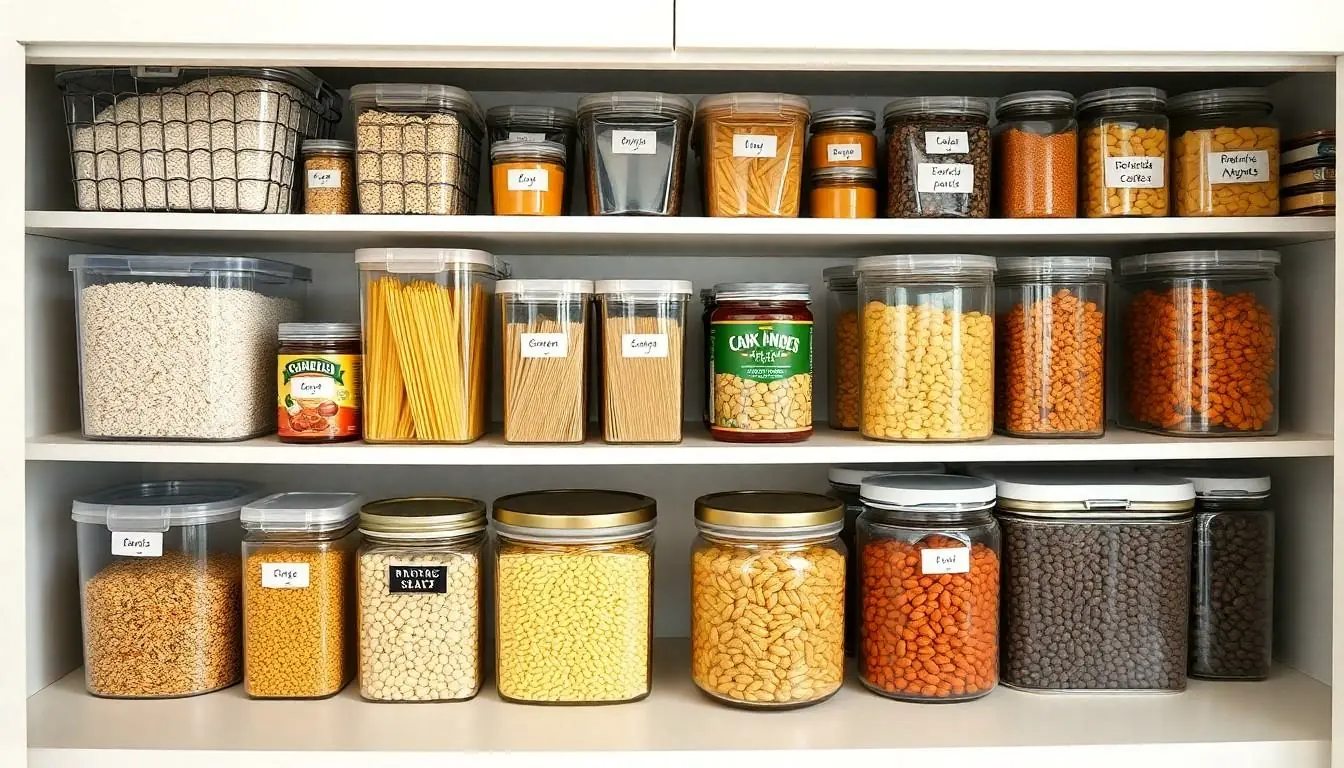Creating a budget-friendly grocery list isn’t just about pinching pennies – it’s about mastering the art of smart shopping while keeping the whole family satisfied. With food prices soaring and wallets feeling lighter these days, families across America are looking for clever ways to stretch their grocery dollars without sacrificing quality meals.
The secret to successful budget shopping lies in strategic planning and knowing exactly what to put on that all-important grocery list. Whether you’re feeding a family of four or trying to manage a household of hungry teenagers, a well-thought-out shopping list can be the difference between staying under budget and watching those grocery bills spiral out of control. Let’s explore how to create a family-friendly grocery list that’ll keep both your pantry and bank account full.
Table of Contents
ToggleWhy Creating a Family Budget Grocery List Matters
A family budget grocery list reduces monthly food expenses by 25-40% through planned purchasing. Organized shopping prevents impulse buys that typically account for 15-20% of grocery bills.
Statistics show the impact of budget grocery lists on household spending:
| Impact Factor | Savings/Benefit |
|---|---|
| Monthly Savings | 25-40% |
| Impulse Buy Reduction | 15-20% |
| Food Waste Reduction | 30-35% |
| Time Saved Shopping | 45 minutes |
Structured grocery lists eliminate duplicate purchases while ensuring essential items make it into the shopping cart. Families experience 30-35% less food waste when following a predetermined list of ingredients tied to planned meals.
Regular list usage creates these specific benefits:
- Maintains consistent monthly grocery spending patterns
- Tracks price changes across frequently purchased items
- Coordinates meal planning with available ingredients
- Prevents multiple trips to the store for forgotten items
- Reduces expired food disposal through intentional purchasing
Budget grocery lists enable families to:
- Compare prices between stores efficiently
- Buy seasonal produce at peak value
- Stock up during sales on shelf-stable items
- Purchase ingredients for complete meals
- Divide shopping between multiple stores based on best prices
- Analyzing spending trends over time
- Identifying areas for cost reduction
- Planning future grocery budgets
- Adjusting quantities based on family needs
- Making informed choices about brand alternatives
Essential Pantry Staples for Budget Shopping
Stocking a pantry with budget-friendly staples forms the foundation of cost-effective meal planning. These long-lasting items provide versatile options for creating nutritious family meals while maximizing grocery dollars.
Grains and Pasta
Basic grains serve as affordable meal bases with extended shelf lives of 6-12 months. Rice varieties include brown rice at $0.80 per pound white rice at $0.60 per pound jasmine rice at $1.20 per pound. Whole wheat pasta costs $1.25 per pound while regular pasta averages $0.95 per pound. Oats provide breakfast options at $0.85 per pound in bulk. Additional economical grain choices include:
- Store quinoa in airtight containers for 2-3 years
- Purchase barley in bulk quantities for $1.15 per pound
- Stock couscous as a 10-minute meal solution
- Buy flour in 5-pound bags to save 20% versus smaller packages
Canned and Dried Goods
- Store lentils in sealed containers for 24-month shelf life
- Buy dried beans at $1.35 per pound versus $0.75 per can
- Keep split peas for protein-rich soups lasting 24 months
- Stock canned tuna at $0.89 per 5-ounce can during sales
- Purchase bulk nuts with 6-12 month shelf stability
- Maintain dried fruit supplies for snacks lasting 6 months
Smart Shopping Strategies to Save Money
Strategic grocery shopping combines careful planning with savvy purchasing decisions to maximize savings. These proven techniques help families reduce their grocery expenses while maintaining nutritious meal options.
Meal Planning Basics
A structured meal plan reduces food expenses by up to 35% through targeted shopping. Creating weekly menus based on pantry inventory eliminates duplicate purchases. Families select 5-7 dinner recipes featuring overlapping ingredients to minimize waste. Cross-referencing planned meals with store circulars identifies opportunities to incorporate sale items. Building flexible menus around seasonal produce cuts costs by 20-30%. Planning portions accurately prevents overbuying perishables.
| Meal Planning Impact | Savings |
|---|---|
| Weekly Food Cost Reduction | 35% |
| Seasonal Produce Savings | 20-30% |
| Food Waste Reduction | 40% |
Using Store Sales and Coupons
Digital coupons paired with store sales multiply savings opportunities by 40-60%. Store loyalty programs offer personalized deals based on shopping patterns. Stacking manufacturer coupons with store sales reduces item costs by up to 75%. Mobile apps track price drops across local stores. Stock rotation schedules indicate optimal times for markdown purchases. Rain checks secure sale prices when items sell out. Price matching policies enable customers to get competitor deals without extra trips.
| Coupon Strategy | Maximum Savings |
|---|---|
| Digital + Store Sales | 40-60% |
| Manufacturer + Store Coupons | 75% |
| Loyalty Program Savings | 25-35% |
Best Budget-Friendly Foods for Families
Creating a well-balanced family menu starts with selecting affordable foods that deliver high nutritional value. Strategic food choices maximize the grocery budget while meeting dietary needs for every family member.
Affordable Protein Sources
Eggs cost $2-3 per dozen providing complete protein at 20¢ per serving. Large cans of tuna at $1-2 each yield 4-5 servings of lean protein. Dried legumes like black beans lentils cost 80¢-$1 per pound offering 12-15 servings of plant-based protein. Whole chickens priced at $1.50-2 per pound generate multiple meals through meat portions bone broth. Buying family packs of chicken thighs pork shoulder ground turkey during sales drops protein costs to $2-3 per pound. Store brand Greek yogurt provides protein calcium at $3-4 per 32oz container.
Low-Cost Fresh Produce
Seasonal vegetables fruits offer peak nutrition at lowest prices. Root vegetables like carrots potatoes onions cost 50¢-$1 per pound lasting 2-4 weeks when stored properly. Cabbage priced at 60¢ per pound provides numerous servings raw cooked. Bananas apples oranges average 50¢-80¢ per pound year-round. Frozen vegetables fruits maintain nutritional value at $2-3 per pound. Large bags of spinach mixed greens cost $3-5 providing salads sides all week. Buying produce in season reduces costs by 30-50% compared to off-season prices.
Tips for Sticking to Your Grocery Budget
Strategic shopping habits transform grocery budgets into effective spending plans. Digital tools combined with organized lists create a systematic approach to budget-friendly shopping.
Shopping List Organization
Shopping lists organized by store layout reduce shopping time by 40%. Create categorized sections for produce, dairy, meat, pantry items, frozen foods. Digital apps like AnyList, OurGroceries or Paprika sync shopping lists across multiple devices for family members to add items. Color-coding items based on priority (red for immediate needs, yellow for stock-up items, green for optional purchases) maintains focus on essential purchases. Store-specific lists noting regular prices help identify genuine sales versus marketing tactics.
Avoiding Common Spending Pitfalls
Shopping on an empty stomach increases impulse purchases by 60%. Shop during off-peak hours (Tuesday mornings or Wednesday evenings) for better deal access. Skip end-cap displays, which markup items by 25-30% despite appearing as deals. Compare unit prices rather than package prices to identify true value. Purchase store brands for staple items, saving 15-25% compared to name brands. Use cash envelopes or digital spending trackers to maintain strict budget limits. Check expiration dates to prevent food waste from bulk purchases. Review receipts immediately to catch pricing errors, which occur in 1 out of 12 transactions.
Seasonal Shopping for Maximum Savings
Seasonal produce offers significant savings with price reductions of 30-50% compared to off-season items. Fresh fruits cost 25-35% less during peak growing seasons while maintaining optimal nutritional value. Local seasonal vegetables provide savings of up to 40% compared to imported alternatives.
Peak Season Buying Guide
Spring (March-May)
- Asparagus: $2.50/lb (vs. $4.99 off-season)
- Peas: $1.99/lb (vs. $3.99 off-season)
- Strawberries: $2.99/pint (vs. $5.99 off-season)
- Spring onions: $0.99/bunch (vs. $2.49 off-season)
Summer (June-August)
- Tomatoes: $1.49/lb (vs. $3.99 off-season)
- Corn: $0.50/ear (vs. $1.49 off-season)
- Zucchini: $1.29/lb (vs. $2.99 off-season)
- Peaches: $1.99/lb (vs. $4.49 off-season)
Fall (September-November)
- Apples: $0.99/lb (vs. $2.49 off-season)
- Pumpkins: $3.99 each (vs. $7.99 off-season)
- Sweet potatoes: $0.79/lb (vs. $1.99 off-season)
- Brussels sprouts: $2.49/lb (vs. $4.99 off-season)
Winter (December-February)
- Citrus fruits: $0.69/lb (vs. $2.49 off-season)
- Root vegetables: $1.29/lb (vs. $2.99 off-season)
- Winter squash: $1.49/lb (vs. $3.49 off-season)
- Kale: $1.99/bunch (vs. $3.99 off-season)
Storage Tips for Seasonal Produce
Proper storage extends produce life by 7-14 days. Root cellars maintain vegetables at optimal temperatures of 32-40°F for 3-6 months. Vacuum sealing preserves seasonal fruits for 2-3 times longer than conventional storage methods. Freezing seasonal vegetables retains 85-100% of their nutritional value for up to 12 months.
Conclusion
Creating a family budget grocery list is a powerful tool for smart shopping and financial management. By implementing strategic planning organizing purchases and leveraging seasonal deals families can achieve substantial savings while maintaining nutritious meal options.
The combination of careful list-making savvy shopping techniques and smart storage methods empowers families to reduce their grocery expenses significantly. These practices not only save money but also minimize food waste enhance shopping efficiency and promote healthier eating habits.
A well-planned grocery list serves as the foundation for successful budget management letting families take control of their food expenses while ensuring everyone’s needs are met. With consistent implementation these strategies can transform grocery shopping from a financial burden into an organized cost-effective routine.




